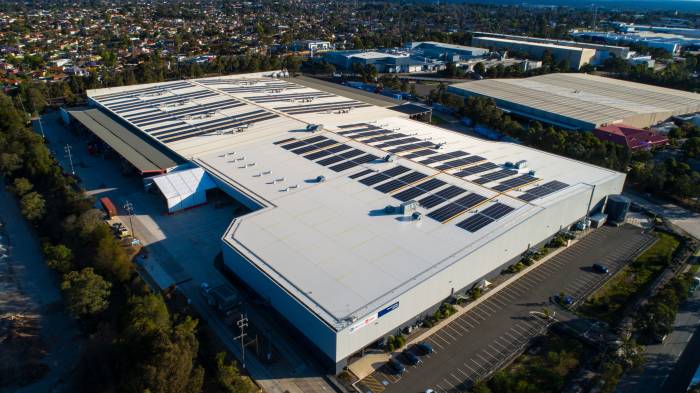Australia Post has announced completion of a $3 million, 2.1MW solar panel system at its parcel sorting facility in Chullora, New South Wales.
While the volume of letters sent in Australia is now 43 per cent below (2016 figures) Australia’s all-time “peak-mail” year in 2007/08, parcel delivery is going gangbusters thanks to the growing popularity of ecommerce. Upgrades at Australia Post’s Melbourne and Chullorah parcel facilities in 2015 enabled these centres to handle more than 1.3 million parcels per day..
The huge PV system, claimed to be Australia’s largest single-roof solar panel installation, is expected to save the service more than $800,000 on its electricity costs annually and avoid 2,200 tonnes of carbon emissions each year.
“Our investments in improving energy and cost efficiency of our buildings have already saved us $40 million,” said Australia Post Group Chief Financial Officer, Janelle Hopkins. ” This project is a strong example of our commitment towards leading with environmentally sustainable business outcomes.”
Australia Post has been somewhat of a quiet achiever on the solar front – the Chullorah installation brings its PV tally to 49 systems and is by far the largest. With 1,100+ Australia Post buildings throughout the country, there’s still plenty of scope for more solar and the corporation has also signalled it is looking into energy storage.
Australia Post is also part of the Melbourne Renewable Energy Project (MREP), a consortium of local governments, institutions and corporations using a group purchasing model with the aim of buying renewables-based electricity at the best rate possible. The MREP is supporting the construction of a new wind farm at Crowlands in Victoria by purchasing 88 gigawatt-hours of its output each year under a long-term power purchase agreement (PPA).
When completed, Crowlands Wind Farm will consist of 39 turbines that will generate clean electricity equivalent to the consumption of more than 50,000 Victorian households, while avoiding 204,800 tonnes of emissions each year.
Australia Post has previously acknowledged climate change is one of the biggest threats facing the world’s future.
Energy use in buildings and facilities accounts for around two-thirds of Australia Post’s carbon emissions. It has set a target to reduce its carbon emissions 25 per cent by 2020, based on 2000 levels. By last year, Australia Post had achieved a 17% reduction.
Other sustainability-related partnerships include its participation in the MobileMuster program, which has seen tonnes of unwanted cell phones dropped off at Australia Post outlets, and Cartridges 4 Planet Ark; an inkjet cartridge recycling initiative.
As for its own recycling efforts, Australia Post says it recycled and reused 12,531 tonnes of materials in 2016.


 RSS - Posts
RSS - Posts



Speak Your Mind